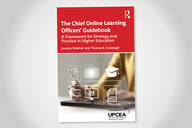You have /5 articles left.
Sign up for a free account or log in.
Do any of you ever go to meetings?
I know that in reality your days are filled with long stretches of uninterrupted time for thinking, contemplation, reading and writing. That you are never distracted by e-mails and meetings.
But pretend that at some point you will have to go to a meeting.
Now also pretend that not everyone who needs to participate in your meeting can attend in person. At least one of the critical meeting participants is working remotely.
How should you have this distributed meeting?
My advice for running successful distributed meetings comes from what I have seen work in synchronous online learning.
If you can get a synchronous online class session to run well - then you can also run a good distributed meeting.
Note - my advice for distributed meetings has nothing to do with webinars. Webinars are almost bad because of issues of scale. There are too many people on most webinars to allow for meaningful conversation. Your model for good distributed meetings should not be webinars, but teaching.
Okay…here is what I recommend:
Recommendation #1 - Use A Synchronous Discussion / Meeting Platform:
Do you have access to a synchronous online discussion / meeting platform on your campus? Maybe WebEx? Or Adobe Connect? Or BlueJeans? Or Join.me? Or GoToMeeting? Or Skype? Or Fuze? Or Zoom? Or Collaborate? What am I missing? There are so many.
The reason that you want an online discussion / meeting platform is that you want the webcams. (You also want the audio - but audio can be done over the phone as well). You also want the space to share your screen, to take notes together, and to run a presentation.
You will also want to have as many meetings as possible on the platform. There is a learning curve to getting the tech work for online meeting platforms. The more that you use the tool the better you will get using it.
Recommendation #2 - Put Everyone on a Level Playing Field:
Your mantra for online meetings should be that everyone in the meeting is equal. The local people should have the same experience as the distant person.
What this means in practice is that you should avoid the temptation to have the local people gather in one room. The local people should attend the meeting in their own offices (or from home - or somewhere else private). Everyone should only be interacting through the meeting platform.
The reason for this is that the majority of communication is nonverbal. If you hold a meeting where some people are in the room together, and some people are remote, the remote people will not be part of much of the communication occurring during the meeting. You want to have everyone work through the same medium as the work of the meeting progresses.
The local people will not want to follow this recommendation. There are strong social reasons for co-workers to gather in one place. Just know that if you don’t break this convention, and hold the meeting where everyone is on the same level, then you will be sacrificing the quality of the meeting for the remote participants. (You may also find that the meeting is awkward and frustrating for the people gathered in the room as well).
Recommendation #3 - Practice Strong Meeting Moderation:
Successful online meetings are like successful synchronous online classes. Somebody is in charge!
In a class, that person in charge is usually the instructor - although sometimes it is an assigned meeting moderator.
The meeting moderator is responsible for making sure that the goals of the meeting are clear, that everyone has the agenda ahead of time, and that everyone in the meeting can contribute and be heard. The online meeting moderator needs to take a firm hand in moving through the agenda, and in making sure that everyone in the meeting is able to make their points and ask their questions.
Recommendation #4 - Follow Good Meeting Practices:
Online meetings leave no room from straying from good meeting practices. Agendas must be sent out ahead of time - with time allocations for each item. Agendas must be reasonable in scope. Action items and accountabilities need to be clear. Next steps need to be clearly defined and agreed upon by everyone.
Meetings are not places to share information. Information should be shared asynchronously. Meetings are about conversations (figuring things out) and decision making. Meetings are for getting work done. If you are not getting work done in the meeting then there is a good chance that the meeting should not be occurring.
These rules are particularly important for online meetings. Most online meetings are terrible. People tune out. They multitask. They read their e-mail. A good online meeting (or class) keeps everyone engaged in the work of the meeting. This engagement comes from the design of the meeting, the work that has been done beforehand to make the time investment worthwhile, and the skill of the meeting moderator.
Care to argue with any of my recommendations?
Does your distributed team follow these practices?
What do you think we can learn from online learning in our efforts to improve our workplace productivity?
Do you have any other recommendations for designing and running a distributed online meeting?




